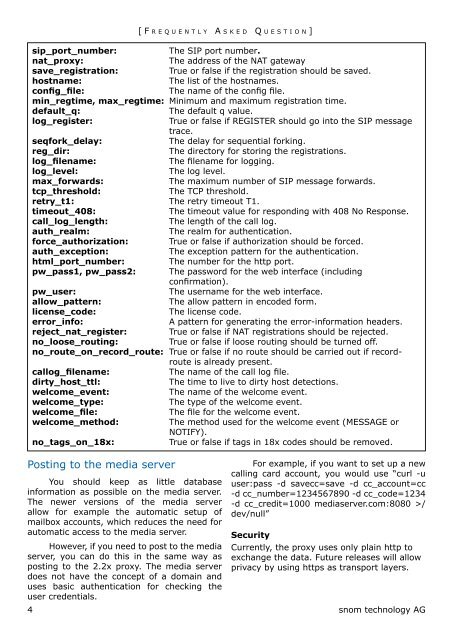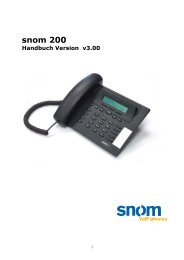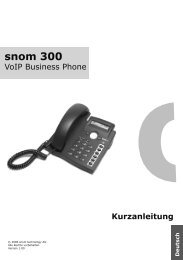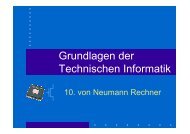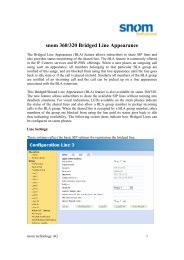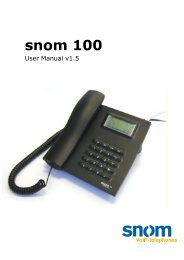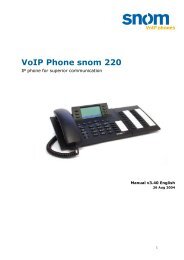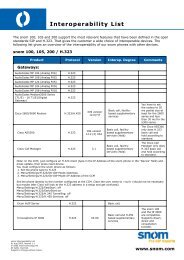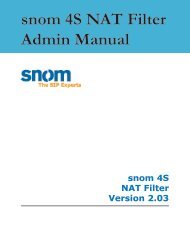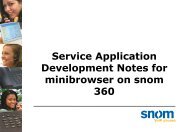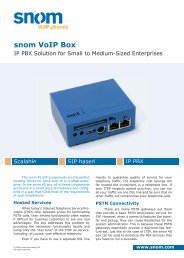F REQUENTLY A SKED Q UESTION - Snom
F REQUENTLY A SKED Q UESTION - Snom
F REQUENTLY A SKED Q UESTION - Snom
You also want an ePaper? Increase the reach of your titles
YUMPU automatically turns print PDFs into web optimized ePapers that Google loves.
[ F R E Q U E N T L Y A S K E D Q U E S T I O N ]<br />
sip_port_number: The SIP port number.<br />
nat_proxy: The address of the NAT gateway<br />
save_registration: True or false if the registration should be saved.<br />
hostname: The list of the hostnames.<br />
config_file: The name of the config file.<br />
min_regtime, max_regtime: Minimum and maximum registration time.<br />
default_q: The default q value.<br />
log_register: True or false if REGISTER should go into the SIP message<br />
trace.<br />
seqfork_delay: The delay for sequential forking.<br />
reg_dir: The directory for storing the registrations.<br />
log_filename: The filename for logging.<br />
log_level: The log level.<br />
max_forwards: The maximum number of SIP message forwards.<br />
tcp_threshold: The TCP threshold.<br />
retry_t1: The retry timeout T1.<br />
timeout_408: The timeout value for responding with 408 No Response.<br />
call_log_length: The length of the call log.<br />
auth_realm: The realm for authentication.<br />
force_authorization: True or false if authorization should be forced.<br />
auth_exception: The exception pattern for the authentication.<br />
html_port_number: The number for the http port.<br />
pw_pass1, pw_pass2: The password for the web interface (including<br />
confirmation).<br />
pw_user: The username for the web interface.<br />
allow_pattern: The allow pattern in encoded form.<br />
license_code: The license code.<br />
error_info: A pattern for generating the error-information headers.<br />
reject_nat_register: True or false if NAT registrations should be rejected.<br />
no_loose_routing: True or false if loose routing should be turned off.<br />
no_route_on_record_route: True or false if no route should be carried out if record-<br />
route is already present.<br />
callog_filename: The name of the call log file.<br />
dirty_host_ttl: The time to live to dirty host detections.<br />
welcome_event: The name of the welcome event.<br />
welcome_type: The type of the welcome event.<br />
welcome_file: The file for the welcome event.<br />
welcome_method: The method used for the welcome event (MESSAGE or<br />
NOTIFY).<br />
no_tags_on_18x: True or false if tags in 18x codes should be removed.<br />
Posting to the media server<br />
You should keep as little database<br />
information as possible on the media server.<br />
The newer versions of the media server<br />
allow for example the automatic setup of<br />
mailbox accounts, which reduces the need for<br />
automatic access to the media server.<br />
However, if you need to post to the media<br />
server, you can do this in the same way as<br />
posting to the 2.2x proxy. The media server<br />
does not have the concept of a domain and<br />
uses basic authentication for checking the<br />
user credentials.<br />
For example, if you want to set up a new<br />
calling card account, you would use “curl -u<br />
user:pass -d savecc=save -d cc_account=cc<br />
-d cc_number=1234567890 -d cc_code=1234<br />
-d cc_credit=1000 mediaserver.com:8080 >/<br />
dev/null”<br />
Security<br />
Currently, the proxy uses only plain http to<br />
exchange the data. Future releases will allow<br />
privacy by using https as transport layers.<br />
4 snom technology AG


